BACK TO EXHIBITS
Quilting Sisters: African-American Quiltmaking in Michigan
Quilting Sisters: African-American Quilting in Michigan
Michigan State University Museum
January 13 - February 13, 2000
The history and culture of any given group can be reflected in the production and use of their material culture. With few exceptions, quiltmaking traditions within the African-American community have been historically overlooked in public and scholarly recognition. In the last five years, however, African-American quilts, quilters, and quilting traditions have begun to receive long overdue attention and have been the subject of several exhibitions and studies.
Research on African-American Quiltmaking in Michigan
In 1983, as part of the Michigan Quilt Project, the staff of the Michigan Traditional Arts Program at the Michigan State University Museum began to systematically collect information on African-American quiltimaking in the state. A series of African-American Community Quilt Discovery Days were held during 1986 in communities of predominantly black populations or historically-important black settlements, including Detroit, Grand Rapids, Muskegon, Lansing, and Idlewild, to encourage quilters and quilt owners to share their quilts and their stories. These community documentation efforts immediately elicited much new information. At the first event, held in Muskegon, the work of more than thirty quilters was recorded. Subsequently, Michigan State University Museum staff, graduate students, contracted researchers, and community scholars have photographed African-American quilts and quilting activities, reviewed primary and secondary archival and library sources, and interviewed more than fifty African-American quilters.
About the Exhibit
This exhibition presents a sampling of quilts that exemplifies the richness and diversity of African-American quiltmaking traditions found in the state. This exhibit explores the ways in which some quiltmakers reflect distinctly African-American experiences. It also demonstrates the wide range of styles, techniques, and traditions that are found among African-Americans in Michigan.
Historical African-American Quilts in Michigan
Although there are few known extant examples of historical quilts and little published information on quiltmaking amount early African-American settlers in Michigan, oral tradition firmly established that quiltmaking has been a widespread activity for many years. One of the few published references to the historical presence of quilts in African-American families in Michigan appeared in the Michigan Manual of Freedom's Progress. The publication accompanied the Michigan Exhibit of Freemen's Progress at the National Half-Century Exposition at Chicago, Illinois, held to celebrate the fiftieth anniversary of emancipation. At least two quilts, one listed as "heir loom, age 60 yrs," were included among nearly two hundred items on exhibit.
One rare nineteenth-century extant quilt with strong Michigan ties is "The Couples Quilt," now owned by collectors in Arizona. According to oral tradition, the quilt was begun by Mary Jane Batson who had been a slave on the Batson plantation outside of Richmond, Virginia. She later gave the pieces to her granddaughter, Mariah Chapman, who set them together and quilted the top. In 1922 Chapman gave the quilt to her niece Malinda Spain who lived in Detroit. Spain, in turn, gave the quilt to William Kern, a school principal, in appreciation for helping to feed and clothe her children during the Great Depression.

The Couples Quilt
Mary Jane Batson
Richmond, Virginia
Private Collection

Oak Leaf
Maker unknown
c1850
Probably Alabama
Collection of the Michigan State University Museum acc.#6646.1
This finely stitched Oak Leaf block has been attributed to an Alabama slave, a relative of Mattie Baker of Inkster, Michigan. This block was one of seven identical blocks passed down through Baker's family. In 1972, Baker gave the blocks to her friend Patricia Anderson of Roscommon, who pieced six of them together to form a small quilt top. Anderson donated the seventh block to the Michigan State University Museum in 1987.
Quilts as Records of Migration
African-American quilts serve as visual records of patterns of migration and settlement. Research has shown that certain quilt patterns, pattern names, color palettes, and construction techniques used by African-American quilters in Michigan are linked to those used by African-American quilters in southern states. Some scholars suggest that the tradition of strip and string quilting among African-American quilters, can in turn, be traced to the textile traditions of their forebears in West Africa.

Old Settler's Quilt
Deonna Todd Green (b. 1948) and Ione Todd (b. 1927)
1990
Remus, Mecosta County, Michigan
Collection of the Michigan State University Museum acc.#7101.1
Perhaps the most ambitious project to document community history was undertaken by Deonna Green and her mother, Ione Todd, of Remus, Michigan. Entitled the Old Settlers' Quilt, the embroidered pictures and words pay tribute to the black families who homesteaded in Mecosta, Montcalm, and Isabella counties in the 1860s and the 1870s. The historical marker celebrating the early settlement of the community by blacks, the local baseball team, the community church and school house, and typical occupations of the early pioneering families are captured on the quilt in thread, paint, and cloth. One block also depicts the annual "Old Settlers' Picnic" in Mecosta to which all of the descendants of the original pioneering families are invited.
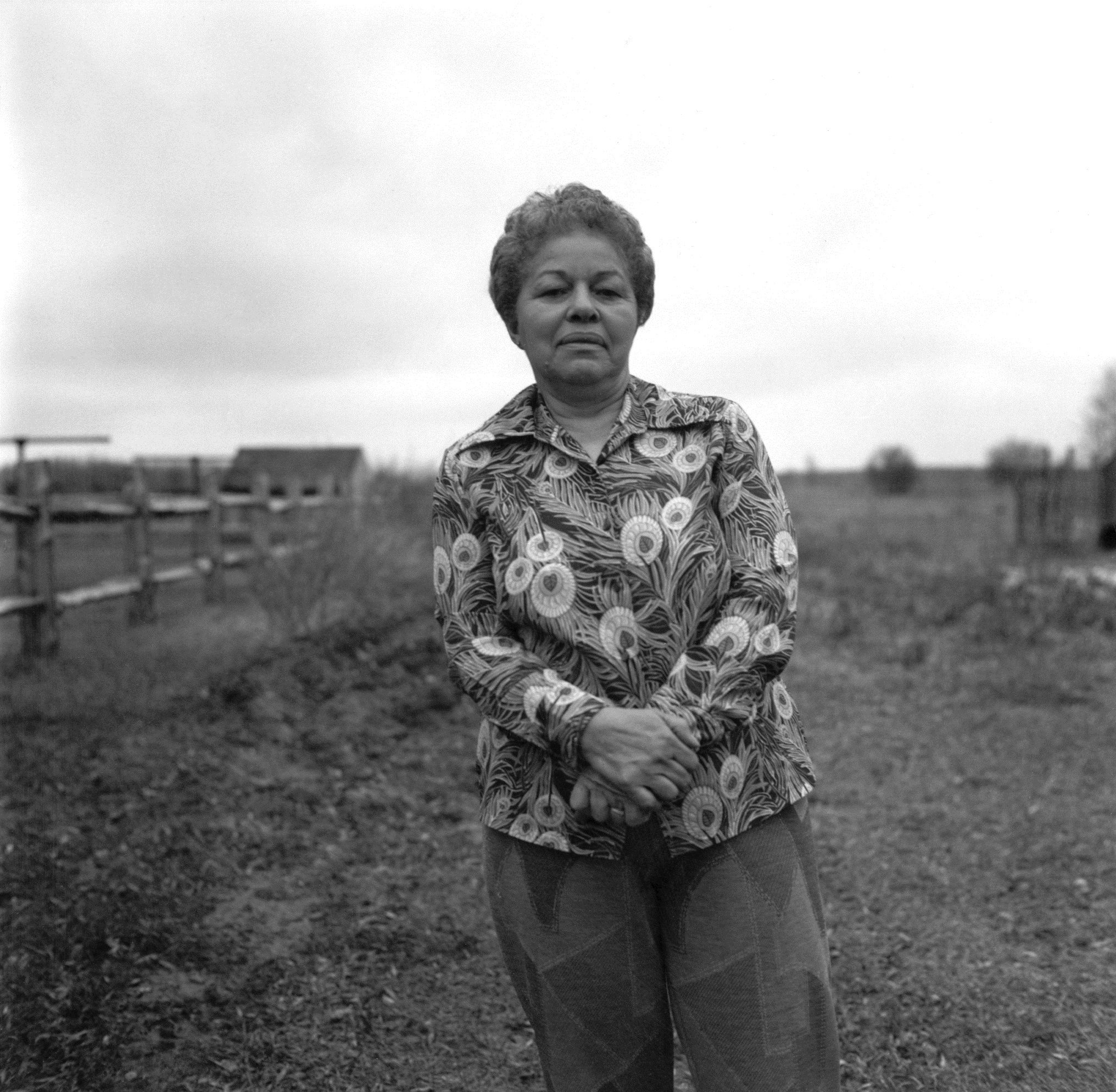
Ione Todd

Viney Crawford
Viney Crawford of Idlewild, Michigan, learned to quilt from her mother and has quilted all her life. While she was growing up, her family had to make quilts because they couldn't afford to buy them. Crawford doesn't use store-bought patterns, but instead makes them up as she goes along, putting scraps together in a way that makes a pleasing design.

String
Viney Crawford (b. 1912)
1986
Idlewild, Lake County, Michigan
Collection of the Michigan State University Museum acc.#6520.1
Crawford's favorite pattern String, is designed to economically use small scraps of fabric. "I don't make really fancy quilts, just something put together." This String pattern quilt was made by Crawford especially for the collections of Michigan State University Museum in honor of the Yates Township Senior Citizen Center in Idlewild.
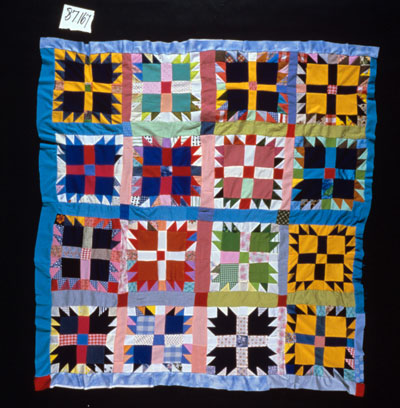
Crow Foot in the Mud
Sina R. Phillips (b. 1901)
1983
Muskegon, Muskegon County, Michigan
Collection of the Michigan State University Museum acc.#6788.1
Quilter Sina Phillip's contention that "any colors look good together" is proven in this quilt top she calls Crow Foot in the Mud.
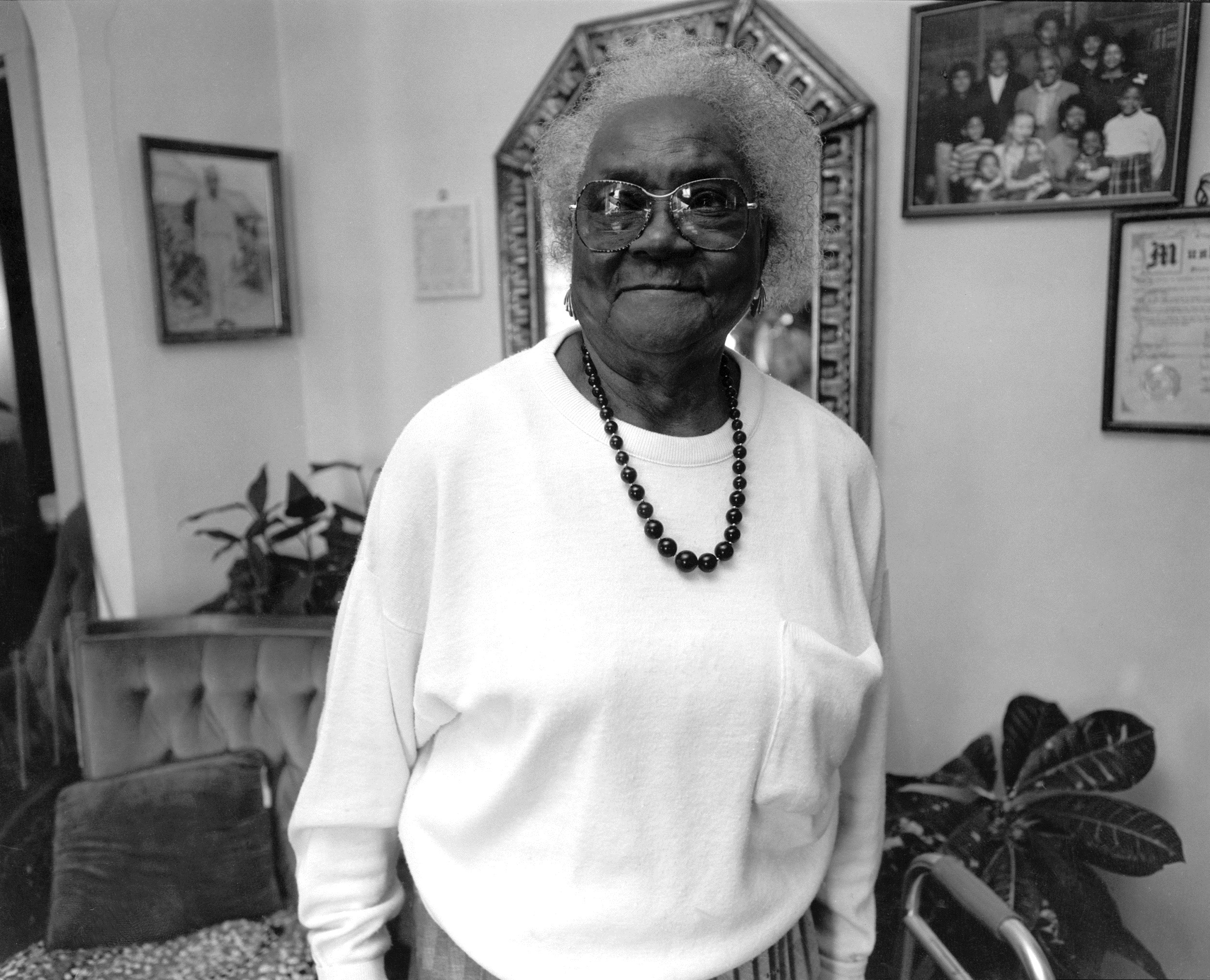
Sina R. Phillips
Born in Demopolis, Alabama, Phillips learned the art of "making covers" from her mother Ida Jones, at the age of ten. She has since made quilting a lifetime hobby, producing more than 50 quilts in all. She copies her patterns from other quilts she sees and has yet to buy a pattern. Phillips has a goal of making a Shirley Pine quilt (one of her favorite patterns) for every member of her family.
Quilts as Visual Records of History
Some types of quilts provide a direct source of historical information. Pictorial quilts provide visual depictions of events, places, and people while friendship, album, and signature quilts provide written evidence of the membership and relationships of certain groups of individuals at particular points of history. Like photographs, autograph albums, diaries, and other tools for recording history, these quilts provide insight into the experience of African-Americans in Michigan.

Todd Family Quilt
Six members of the Todd Family
1989
Remus, Mecosta County, Michigan
In 1983, at the suggestion of Ken Todd, six Todd women began a quilting project to tell the story of Stephen and Caroline Todd and the six generations of their descendants. Family oral narratives, Bible records, and library documents served as sources for the pictorial and narrative family history quilt which was completed in 1985. Significant events and places in the Todd history illustrated in the quilt include Stephen Todd's escape from slavery in Kentucky, his marriage to a white woman, their near-capture when crossing a raft from Port Huron to Sarnia, and their eventual resettlement in Mecosta as pioneering farmers.

Todd Family Quilt
Deonna Todd Green (b. 1948) and Ione Todd (b. 1927)
1989
Remus, Mecosta County, Michigan
Collection of the Michigan State University Museum acc.#7005.1
When the first Todd Family quilt was raffled off to a cousin at one of the Todd family reunions, Deonna Green and Ione Todd decided to make a duplicate. In 1989 they made this third copy which they presented to the Michigan State University Museum.

Ione Todd (left) and Deonna Todd Green (right)
Quiltmaking Traditions
As in any community of quilters, there are a variety of common quiltmaking traditions found in the African-American community. These include the recycling of fabrics from both home and workplace, using quilting to supplement household income, and using quilts as a means to raise funds for local church, community, club activities, or such national causes as the United Negro College Fund.

Zelma Dorris
Zelma Dorris was raised in McCormick, South Carolina, where quilting was popular because there were no blankets or fund for manufactured goods. Among Dorris' maternal relatives were weavers and quilters; by the time she was five, she was threading needles and listening to her grandmother tell spellbinding stories about how quilts were used during slavery. The hems of quilts, she was told, were hiding places for important messages from slave to slave.

Double Wedding Ring
Zelma Dorris (b. 1943)
1985
Detroit, Wayne County, Michigan
Collection of the Michigan State University Museum acc.#7425.1
A wife and mother who formerly served as a clerical worker, Dorris spends all of her spare time visiting quilt shows, talking with quitlers or actually quilting herself. Following in her mother's footsteps, Dorris has won gold ribbons and honorable mentions in numerous exhibits and quilting competitions. The 50 quilts she has completed are of varying fabrics, patterns and colors - reflective of Dorris' eclectic taste as well as her family history. Shoo Fly, for example is her favorite pattern because it is the one she can remember her grandmother using. Her Double Wedding Ring quilt features the attention to detail and form which makes Dorris a noteworthy quilter.
Quilts and African-American Identity
The use of certain motifs, colors, materials, and construction techniques in quiltmaking can underscore an artist's African-American identity. Some quilters choose to incorporate African textiles or fashion their quilts in colors linked to African or African-American social or political organizations.

Lula M. Williams
Lula William's family and friends have affectionately called her "Glamour Girl" for years, and therefore, found it difficult to believe she would become a quilter. Yet, since completing her first Pinwheel quilt more than 20 years ago, Williams has not only made over 100 quilts and won numerous awards, but has also become a quilting teacher at the Evans Recreation Center on Detroit's northeast side. When she was a little girl, Williams occasionally helped her mother with her quilting by putting colors together and piecing. When her won son was 13, he encouraged her to take a six-week course in quilting at this school; she remembered her mother's techniques almost immediately and has been quilting every since.

I Am
Lula M. Williams (b. 1925)
D1987
Detroit, Wayne County, Michigan
Collection of the Michigan State University Museum acc.#7422.1
Williams, who has been a professional quilter for many years, considers construction and coloring the key ingredients of a "good" quilt. Both are clearly evident in her original, award-winning I Am quilt. Illustrated are the seven "I am's" which Jesus utters in the Bible, plus many of the "I am's" which African-American preachers often use at the end of their sermons.
Quilts and Storytelling
As families have brought quilts to Michigan from other states or countries they have brought with them stories of the families and communities left behind. Many African-American quilts in Michigan are made of scraps of clothes worn by family members or are given as gifts on such special occassions as births, weddings, anniversaries, and graduations. Quilts serve as visual reminders of those important events in the retelling of stories associated with those events.

Mary Atkins
Atkins grew up in rural Arkansas and was about eight years old when she learned to quilt from her mother who made quilts for family use. According to Atkins, her mother taught her and her sisters to quilt in order to keep them out of mischief after they had finished school or after doing their chores on the family farm. "There was no playing after work, but I'd sit down on a stool and begin piecing."

Stove Eye
Mary Atkins
c1970
Kalamazoo, Kalamazoo County, Michigan
Collection of the Michigan State University Museum acc.#7132.1
Atkins generally constructs her quilts in the strip fashion and uses scraps of cottons that she receives from friends and relatives. The Stove Eye quilt was inspired by watching an advertisement on television for waterbeds. The advertisement displayed a bed with a commercial quilt on it. She has made quilts as presents for all of her four children and numerous grandchildren and occasionally sells her quilts.

Essie Lee Robinsong
"Quilting gives me a reason to get up in the morning. It works my brain creatively," says Essie Robinson. Quilting has fueled this 72-year-old artist's life since the late 1940's. Her first attempts at quilting, however, were made while she was growing up in Augusta, Georgia. Both her mother and grandmother quilted using bleached sacks and whatever else was avaialable. But because Robinson quilts for beauty in contrast to her relatives who quilted for warmth, she sees her skills as being self-taught rather than a continuation of the family tradition.

Blue Jean Pockets
Essie Lee Robinson (b. 1918)
1990
Detroit, Wayne County, Michigan
Collection of the Michigan State University Museum acc.#7536.1
The mark of an Essie Lee Robinson quilt is that it is reversible so that there are always two quilts in one. A lover of fabric, Robinson has used materials as diverse as cotton, antique satin, and denim. She works a pattern out in her hread and then goes straight to the fabric using a plastic ruler and fabric cutter. Looking at this example of her work, it is easy to understand why she has been the recipient of numerous citations.
Quilting as Social Activity
Quilting has traditionally served as an opportunity for social interaction and the popularity of African-American quilting groups has increased in recent years. From The Quilting Six of Ecorse to the African-American Quilting Club of Flint to the especially strong group headquartered at the Hartford Memorial Baptist Church in Detroit, quilting affords an important opportunity to share productive time with friends in churches, homes, and recreational and senior centers around the state.

Myla Perkins and The Quilting Six
The members of the Quilting Six are connected in a number of ways, including sorority membership and friendships formed in college. There are two sets of natural sisters within the group: Myla Perkins and Clara Clark, as well as Charlesetta Buie and Elizabeth Jaggers. The remaining members, Alva Gamble and Gwen Spears, agree with the others that, after years of quilting, talking, and encouraging one another, the ties that bend them are stronger than ever.
Jaggers says that when family and friends doubted that "six beautiful, intelligent black women were getting together to quilt," The Quilting Six held their own exhibit and displayed more than 70 quilts. Visitors were so impressed, many asked to join the group. The members have decided not to expand, choosing rather to encourage others to begin their own groups.

Underground Railroad or Grandmother's Fan Variation
Myla Perkins (b. 1939)
1984
Detroit, Wayne County, Michigan
Collection of the Michigan State University Museum acc.#7421.1
This Underground Railroad/Grandmother's Fan Variation quilt was submitted by Perkins, the most prolific quilter in the group, who learned to quilt from a neighbor and by reading scores of books. She, in turn, taught the rest of the women, each of whom has already involved in other creative arts.
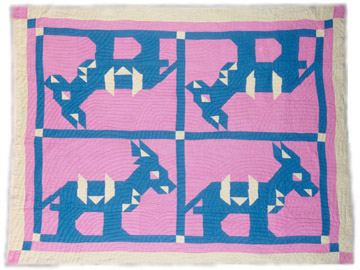
Donkey
Mary Williams (1893-1979)
1939
Kerrville, Michigan
Collection of the Michigan State University Museum acc.#7535.1
Mary Williams was the daughter of a slave and came from an active quilting family. She was an avid seamstress who made all of her husband's and children's clothing. This quilt was given to Williams' grandson Joe on the occasion of his wedding in 1969.

Lucille Rolston
Inspired by the seven unquilted tops that she inherited from her mother, Williams' daughter, Lucille Rolston, joined the Afro-American Quilt Guild in Flint, Michigan, and learned to quilt.
Individual Expression: Quilter as Artist
Although all quiltmaking involves creative decision-making, there are also quiltmakers who consciously strive to use pattern, color, fabric, and craftsmanship to create innovative or unique textiles. These artist/quiltmakers, such as Detroiter Carole Harris or Lethonee Jones of Kalamazoo, participate in such public forums as galleries, exhibits, or fairs where their work is evaluated by art critics or professional quilting judges.

Carole Harris
Carole Harris became interested in quilting because it seemed to be a "non-intimidating art form." What started as a "fun" craft project for her has grown into a serious avocation. Like traditional quilters, Harris works with fabrics that she has on hand; she thinks of herself as a collector of fabrics first, and as an artist second. Harris usually approaches a quilt or project with a sketch, "but it sometimes controls itself, it takes over and becomes what it wants to become."
"The process of making a quilt is like the art of a jazz musician - they start with a melody and improvise from there. Both jazz and quiltmaking are spontaneous, putting little bits of things together to make a complete piece of art."

Title
Quiltmaker
Date
City, County, Michigan
Collection of the Michigan State University Museum acc.#
Harris is grateful for her strong art background because it helps her see the designs in things. "I see quilts everywhere. In something as unlikely as a flower, or in architecture. You can look all around you in nature for color schemes, you don't have to be original, there are a lot of things already done for you. I'm very attractive to linear elements, and I see those lines everywhere." Harris is fascinated with what occurs when she plays with pattern and color. She describes her art as "painting with fabrics" because she uses color the way that a painter would. Her favorite color is balck because it makes all the other colors look so vibrant. Harris works mostly with the string pattern because it is so amenable to the mixing of fabric and color.

Lethonee Jones
Lethonee Jones, a faculty member at Western Michigan University, first learned the basic Nine Patch from an American doctor's wife while serving in the Peace Corps in Africa in 1963. Upon her return to the states, her interest in quilts was further bolstered by the recognition of quilters within the family and the receipt of a quilt block from her husband's family. The large collection of cloth scraps that she accumulated in Africa and shipped back to the states served as her initial basic scrap bag for piecing quilts. According to Jones, it is important for her to use materials or symbols in her quilts that are "vital and a part of the African heritage."
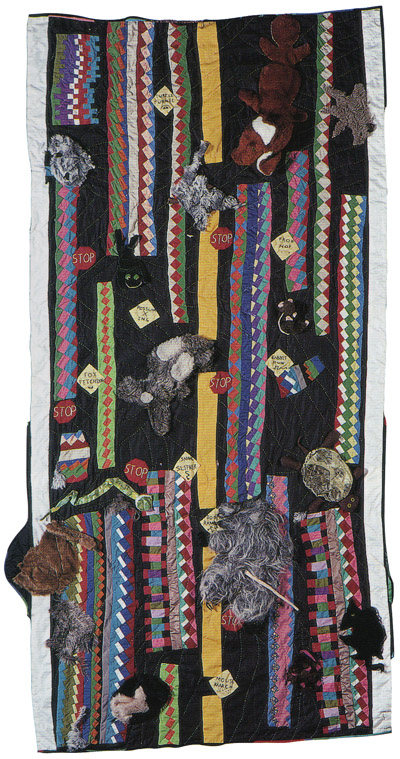
Roadkill
Lethonee Jones (b. 1938)
c1986
Kalamazoo, Kalamazoo County, Michigan
Collection of the Michigan State University Museum acc.#1996:109.1
Roadkill is "an ecological statement about the waste of little animals ... and I wanted to also try out some Seminole piecing techinques." Jones also worked into this quilt some of the soft sculpture techiniques she has honed in her fifteen years of working as a volunteer in the costume department of the Kalamazoo Civic Theater.
Quilting has significance for Jones because "it is something that human hands have done ... It is something a person can do, and it is in your control." Jones' quilts have been exhibited in numerous quilt and art exhibitions in the Kalamazoo area and around the state.

Elaine Yancy Hollis
Although Elaine Hollis is the granddaughter of a quilter and the daughter of a seamstress, she did not begin quilting until c1980. During the time that she worked for the federal government, a colleague begeed her to take a quilting class. Hollis finally relented, planning to pass the techniques on to a friend. Instead, she added quilting to her long list of artistic endeavors. The married mother of three and grandmother of four has produced more than 40 quilts and usually has from five to eight in progress at any given time.

Todd or Pyramid
Elaine Yancy Hollis (b. 1936)
1985
Detroit, Wayne County, Michigan
Collection of the Michigan State University Museum acc.#7424.1
Hollis drafts her own patterns and uses a variety of lap hoops. She does not favor any particular pattern, but she is partial to applique work and to creating illusions - two of the hallmarks of her quilting work.
Hollis says quilting means several things to her, "Relaxation. Creativity. Sprituality. Being able to leave somewhat of a legacy. Being able to use one of the talents that I received from God." Her black Pyramid quilt is evidence of her ability to pair vibrant colors with black and achieve stunning results.
The Michigan Quilt Project
Established in 1984 under the direction of the staff of the Michigan Traditional Arts Program at the Michigan State University Museum, the Michigan Quilt Project was created to systematically research, document, and present information on this important aspect of the state's cultural heritage. In addition to photographs, tape-recorded interviews, and data on more than 5,000 quilts representing the work of over 3,000 quilters, the Michigan State University Museum has received numerous donations of significant Michigan quilts. These collected objects and information have provided the basis for a variety of public education and scholarly research projects. The project has resulted in publications, public educational programs, and interpretive exhibitions at the museum.
The Michigan State University Museum is continuing to seek information on quilts and quiltmakers. Visitors with information or quilts to contact the Michigan Quilt Project at donald20@msu.edu.
Acknowledgements
This exhibition was sponsored by the Museum of African-American History, the Detroit Historical Museum, the Mayor's Office of Idlewild, the Minority Affairs Office of Muskegon Community College, and the Cooperative Extension Services offices in Kent, Muskegon, Lake, and Ingham counties.
Funding for this project has been provided by grants from the Michigan Council for the Arts, Michigan State All-University Research Initiation Grant Program, Michigan State University Foundation, Greater Lansing Foundation, Michigan State University Black History Celebration Committee, and the Folk Arts Program, National Endowment for the Arts. Additional support was provided by the Michigan State University Offices of the Provost and Vice-President for Research and Graduate Studies and the Lila Wallace-Reader's Digest Fund. The Michigan Traditional Arts Program is a partnership program with the Michigan Council for Arts and Cultural Affairs.
Exhibit Project Staff
Project Curator: Marsha MacDowell
Project Researchers: Deborah Smith Pollard; Marie Combs; C. Kurt Dewhurst; Wythe Dornan; Ruth D. Fitzgerald; Deborah Grayson; Junius Griffin; Denise Pilato; Maryellen Haines; Catherine Johnson; LuAnne G. Kozma; Yvonne R. Lockwood; Cheryl Lyons-Jenness; Marsha MacDowell; Lynne Swanson; and Peter H. Wehr.
Photographer of quilters (unless otherwise noted):
Mary Whalen
Exhibit Designers: Lynne Swanson, Carole Harris, and Melinda Hamilton
Collections Manager: Lynne Swanson
Curatorial Assitants: Melaine Atkinson, Chantel Cummings, Catherine Johnson, Beth Donaldson, Kate Edgar, Mary Worrall, Sarah Stollack, Pearl Yee Wong, and Jill Crane
Exhibit Technician: Julie Levy-Westin
Signage Production and Layout: Melinda Hamilton and Dustin O'Connor
Advisory Committe Members: Jeffalone Rumph; Derenda Collins; Carole Harris; Anita Marshall; Marie Combs; Ben Miller; Maryellen Haines; and Cheryl Lyons-Jenness
Traveling Exhibit Coordinator: Michele Beltran
An accompanying publication: Marsha MacDowell, ed. African American Quiltmaking in Michigan. East Lansing, Michigan; Michigan State University Press, 1998.
-
Museum
Michigan State University Museum Michigan Quilt Project
-
Quiltmaker
Atkins, Mary Michigan African American Quilt Project
-
Quiltmaker
Crawford, Viney Michigan African American Quilt Project
-
Quiltmaker
Dorris, Zelma Michigan African American Quilt Project
-
Quiltmaker
Green, Deonna Michigan African American Quilt Project
-
Quiltmaker
Harris, Carole Michigan African American Quilt Project
-
Quiltmaker
Hollis, Elaine Yancy Michigan African American Quilt Project
-
Quiltmaker
Jones, Lethonee Michigan African American Quilt Project
-
Quiltmaker
Perkins, Myla Michigan African American Quilt Project
-
Quiltmaker
Todd, Ione Michigan African American Quilt Project
-
Quiltmaker
Williams, Lula Michigan African American Quilt Project
-
Collection
African American Quilt Collection
Michigan State University Museum
-
Ephemera
Womenfolk 22. African American Quilts:...
Breneman, Judy Anne
-
1986
String Quilt Crawford, Viney
-
1970
Stove Eye Atkins, Mary
-
1976-1999
Crow Foot In The ... Phillips, Sina
-
1990
Todd Family Histo... Green, Deonna
-
1984
Underground Railr... Perkins, Myla
-
1987
I Am Williams, Lula M.
-
1990
Appropriateness o... Harris, Carole
-
1985
Todd or Pyramid Hollis, Elaine
-
1985
Double Wedding Ri... Dorris, Zelma
-
1940
Donkey Williams, Mary
-
1990
Blue Jean Pockets... Robinson, Essie Lee...
-
ca 1986
Roadkill Jones, Lethonee
-
1990
Old Settlers' Reu... Green, Deonna
-
c1840-1860
Oak Leaf Unknown, attributed...
-
1983
Todd Family Quilt... Green, Deonna
Load More